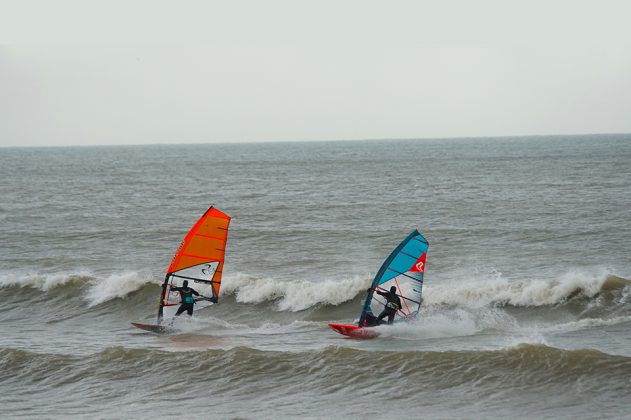ALL WEATHER DRIVE –
6.0M CROSSOVER SAIL TEST 2020
Test Editor Tris Best // Second Testers Maurin Rottenwalter, Joe North & Dan Hallam
Photos Team Newwave // Test location Portland Harbour and Overcombe.
The crossover sail, by virtue of its sizing and job description, has to be the most versatile of all sail types. Whether its DNA has roots in the wave arena, no-cam freerace or high-wind freeride, the idea of one sail adapting to different roles makes it a popular choice for many. We handed over eleven of the latest designs to the team to put through their paces.
This test was originally published in the April 2020 issue of Windsurf Magazine.
FINDINGS
Sitting next to wave sails in most brands’ lineups; the crossover sail could be classed as the first category that is primarily focussed around the recreational sailor. Whereas wave sails are designed to meet the demands of the world’s elite (and rigours of the most challenging conditions), the crossover sail is developed by brands with the consumer market in mind, and as a result the priorities of the design brief can be very different. Practicality of rig and set, wind range and handling ease are probably the main goals here; hassle-free sailing that will flatter the rider and keep them coming back for more. That said, some brands have consciously taken the decision to omit a ‘crossover’ focussed category, perceiving it as an unnecessary ‘dumbing down’ exercise, patronising the consumer. Their argument is that the requirements and demands of both the recreational sailor and the pro are synonymous, so the obvious choice for this category is the 5-batten wave sail. And we have a few included here.
All the sails on review here adopt a 5-batten structure and all set on 430 cm masts, (even the ‘foldable’ RRD). The feel most are aiming for is soft and smooth, combined with easy handling and range, which means most have a forward focussed centre of effort. In pushing the draft forwards, the tension and luff curve required to lock the stability in place can be reduced, breathing more life and connection with the mast into the sail and more bottom end response as a result. If the remit is for a manoeuvre-oriented feel, then the sweet spot tends to be focussed higher in the draft; if it’s more freeride in nature then the sweet spot is dropped lower towards the sail’s tack. There are a couple of sails in this test group that purport a different feel and proposition, shifting the draft back to sit around the rider. In doing so, they bring a different feel and balance, as well as power management – something that will undoubtedly find favour with the more assertive and adventurous. And as with last year, there is an ever-increasing shift in the wind foiling world towards manoeuvre-oriented, recreational freeride foiling, expanding wind ranges and enjoyment possibilities. Some of these sails make simply stunning kick-start engines for a foiling setup, in addition to their main marketed briefs. If you’re foiling as well, or looking to get into it, this has got to be a consideration in choosing your new sail.
SUMMARY
Let’s start with the wave sails amongst the group and the Purelip from Loftsails is somewhat of a brand foundation, having been in its range for the last 20 years. It has near legendary status when it comes to top end handling and control, and this year is no exception. The Wave from Ezzy extends up to 5.8m, gaining a batten yet losing none of its incredible range and new-found light-weight handling or response. The Atlas makes a return to Neil Pryde’s ranks too, and becomes a platform to exhibit the brand’s reputed scrim laminates. It has the looks, the handling … and potentially the price tag if you want to go all out! There are then several sails in the group that undoubtedly have more focus on straight-line / flat water work. The Hybrid from GA Sails is long in boom and super easy in nature, asking to be locked in for some long-distance freeride cruising. Severne’s Gator takes light-weight handling to another level. A sail that is so effortless and user-friendly that it practically sails itself, accelerating in gusts and pulling almost magically through lulls. The Simmer Enduro and Goya Nexus both offer a different proposition, focussing the draft position around the rider for more obvious feedback and response. The Simmer has a softer delivery and is incredibly balanced; the Nexus is tight like a drum and gives that extra little something to play with and explore through the back hand. The Compact Fire from RRD has its roots firmly planted in the straight-line/freerace quarters and is a match for any here when properly powered. Its USP is obvious and should be commended; in times when it is becoming increasingly hard to travel with kit on flights, this could be a genuine solution. And best of all, performance is no longer the trade-off. So onto the all-rounders; the ones with their feet in both camps – flat-water and coastal / waves. The Super Session from Duotone has a cleaner, more eye-catching graphic for 2020, and has a very connected and enjoyable character. The Torro from Gunsails uses conventional dependable materials and shaping-techniques to produce a sail that everyone got on with. There is nothing innovative or pioneering about it, but it comes at a price that should rightly make many stand up and take note. That leaves the Spy from Point-7, a sail that has been re-branded and re-defined verbally by its creators several times in recent years, but for good reason; it is so universally liked and capable that it is hard to describe succinctly!
THE LINE UP



